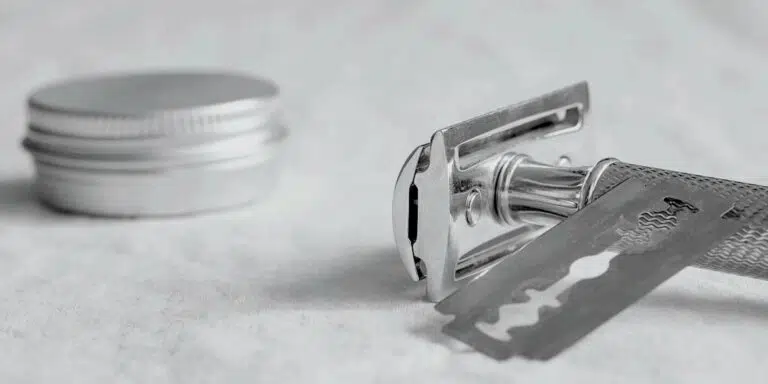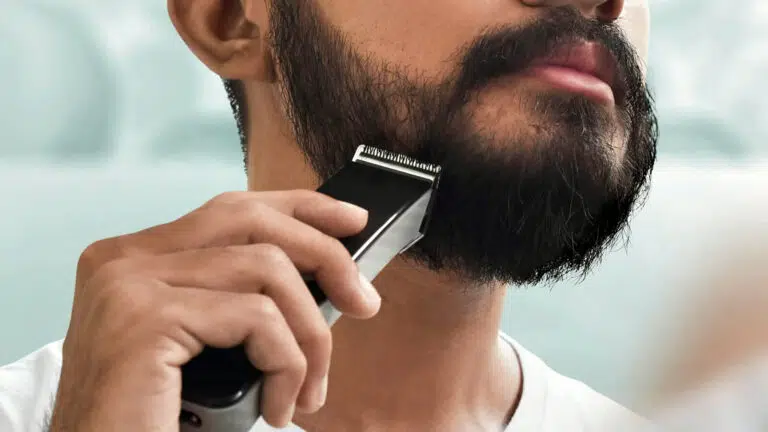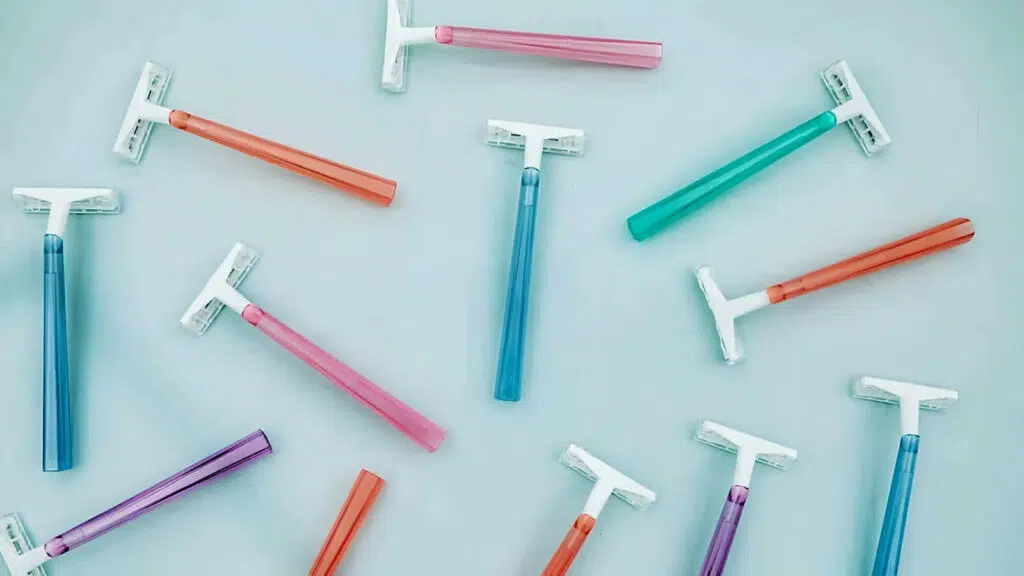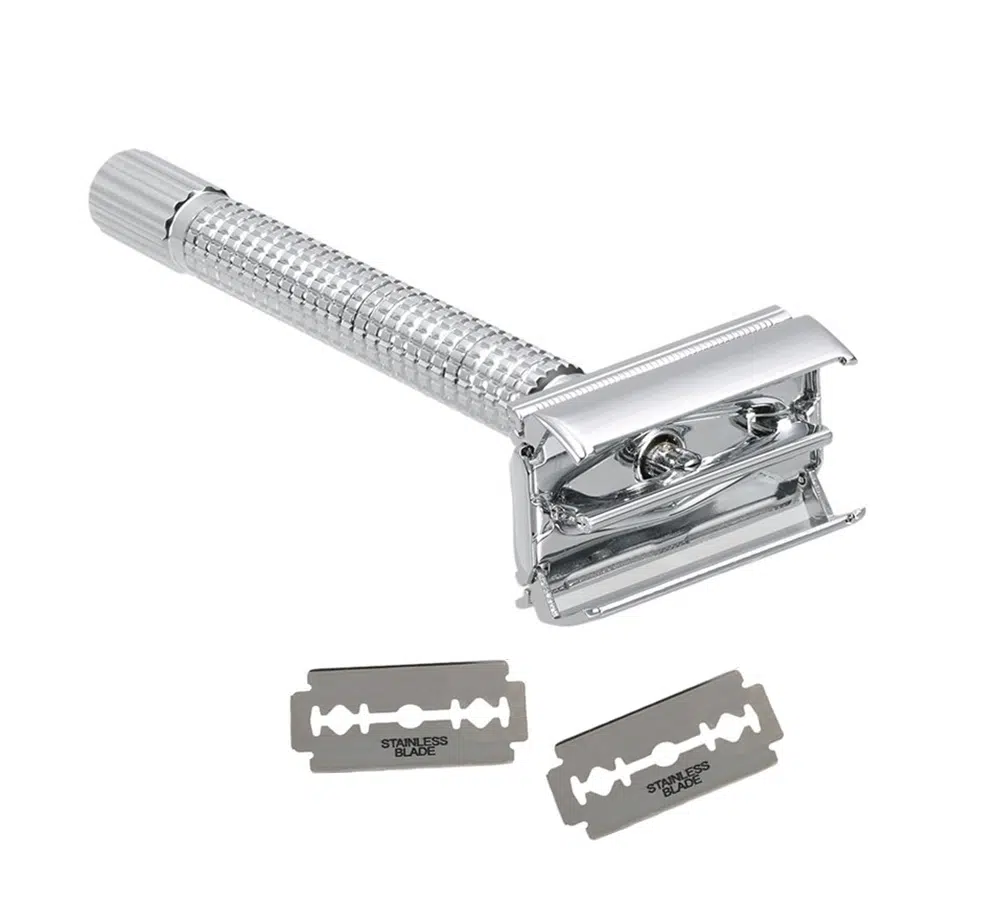
Introduction
For millennia, humans have pursued the art of shaving. In ancient civilizations, sharpened stones and bronze blades marked the earliest attempts at hair removal, signifying status and refinement. Fast-forward to today, razor blades have evolved into symbols of precision and innovation, playing a pivotal role in our grooming rituals.
The modern quest isn’t just about hair removal—it’s about achieving the elusive ‘perfect shave.’ This pursuit is more than skin profound—a close, flawless shave impacts our appearance and skin health. The right razor blade ensures fewer nicks and cuts, reduces the risk of ingrown hairs, and maintains the skin’s vitality. Conversely, an ill-suited edge can spell a myriad of skin woes.
This guide dives into the nuanced world of razor blades, highlighting their historical significance and undeniable impact on our quest for aesthetic perfection and skin well-being.
Understanding the Basics of Razor Blades

When diving into the world of shaving, one quickly realizes that not all razor blades are created equal. There’s a vast array of types, each designed with specific features catering to varied needs:
- Safety Razors: These have been popular since the early 20th century, offering a protective guard between the blade and the skin. Safety razors typically use double-edged blades, providing a close shave while minimizing nicks and cuts.
- Straight Razors: Often seen in classic barber shops, straight razors, or ‘cut-throat’ razors, are a single long blade that requires careful handling. It offers the closest possible shave but comes with a steep learning curve.
- Cartridge Razors: Commonly seen in most households, these feature multiple blades stacked together in a cartridge. They’re user-friendly, but the replacement cartridges can often be pricey.
- Disposable Razors: These are single-use razors, perfect for travelers or those in a pinch. While convenient, they aren’t always eco-friendly or the best for a high-quality shave.
Now, when it comes to the materials that forge these blades, there are predominantly two contenders:
- Stainless Steel: Widely used due to its resistance to rust and corrosion. Stainless steel blades offer longevity and consistent sharpness, ensuring a reliable shave.
- Carbon Steel: While sharper than stainless steel, carbon steel blades are more prone to rust. They require meticulous care but reward users with an exceptionally close shave.
Understanding these basics will arm you with the knowledge to select the blade that aligns best with your shaving needs and skin type.
Factors that Affect the Quality of a Shave

The type or material of your razor blade only partially determines a great shave. Several nuanced factors come into play, each holding the potential to elevate or compromise your shaving experience:
- Sharpness: It might seem counterintuitive, but a sharper blade is generally safer and provides a better shave. A dull blade tugs at hairs, causing irritation and increasing the risk of cuts as one might press harder. Conversely, a sharp blade glides smoothly, cutting inches at the skin’s surface with minimal friction and offering a close, comfortable shave.
- Blade Coating: Modern blades often come with coatings that enhance their performance and lifespan. Teflon, for instance, reduces friction, making for a smoother glide. Chrome, on the other hand, prevents rusting and enhances blade longevity. These coatings ensure the blade retains its edge and reduce skin irritation, which is especially crucial for those with sensitive skin.
- Blade Flexibility: Razors are no longer rigid, unyielding tools. Many modern designs offer blades that flex, pivot, or adjust based on the pressure you apply. This flexibility ensures the blade contours to your face’s unique angles and curves. It provides consistent contact with the skin, allowing for an even shave while minimizing the risk of nicks, especially in tricky areas like the jawline or the Adam’s apple.
In essence, the minutiae of blade design and technology play a pivotal role in the quest for the perfect shave, emphasizing the importance of choice and understanding.
Choosing the Right Razor Blade for Your Skin Type
Just as skincare products should be tailored to individual needs, so should your razor blade. Your skin type and hair texture significantly determine which edge will deliver the optimal shaving experience.
- Sensitive Skin: If your skin is prone to irritation or redness, consider blades with specialized coatings like Teflon, which reduce friction. Additionally, a razor with a lubricating strip containing aloe or vitamin E can provide an added layer of protection. Steer clear of blades with too many edges, as they might over-exfoliate the skin, leading to further irritation.
- Coarse Hair vs. Fine Hair: Coarse hair demands a sharp and durable blade. Stainless steel is often preferred as it retains sharpness over multiple uses. For those with finer hair, flexibility and precision take precedence. A razor that contours well, perhaps with a pivoting head, can be more effective in ensuring all strands are caught and cut.
- Common Shaving Issues:
• Razor Burn: Often a result of using a dull blade or pressing too hard. Ensure your blade is sharp and let it glide over your skin without excess pressure.
• Bumps: These can arise from hairs curling back into the skin. Using a blade with fewer edges and exfoliating before shaving can help prevent this.
• Nicks: Caused by uneven shaving or sudden movements. A flexible blade that contours to your face can minimize this risk.
Selecting the right blade isn’t just about getting a close shave; it’s about ensuring your skin feels and looks its best post-shave.
Tips for Achieving a Closer, Smoother Shave

Achieving that perfect, smooth shave isn’t just about the razor blade you choose; it’s also about the technique and care you apply before, during, and after the act. Here are some expert tips to ensure your skin remains smooth and supple post-shave:
- Skin Preparation:
- Exfoliation: Gently exfoliating your skin removes dead skin cells, allowing for a smoother razor glide. It also helps prevent ingrown hairs by ensuring the hair follicle isn’t blocked.
- Hot Water: Before shaving, rinse your face with hot water or take a warm shower. This opens up the pores and softens the hair, making it easier to cut.
- Quality Shaving Creams/Gels: Invest in a good shaving cream or gel that provides adequate lubrication. It creates a barrier between the blade and your skin, reducing the risk of cuts and irritation.
- Optimal Razor Angle: Hold the razor at about a 30-degree angle to your skin. This allows the blade to cut the hair effectively without being too aggressive. Remember, let the blade do the work; there’s no need to apply excessive pressure.
- Post-Shave Care:
- Cooling: Rinse your face with cold water post-shave to close the pores and reduce inflammation.
- Moisturizing: Apply a quality, alcohol-free moisturizer to rehydrate the skin and prevent dryness.
- Protecting: If you’re stepping out, consider using a moisturizer with SPF to shield the freshly shaved skin from the sun’s harmful rays.
Implementing these tips will ensure that every shave you have is close and kind to your skin.
Maintenance and Storage
You’ve chosen the perfect razor blade and mastered the art of shaving. But to ensure the longevity of your blade and maintain its effectiveness, proper care, storage, and timely replacement are vital. Here’s how to make the most of your chosen razor:
- Proper Cleaning Techniques:
- Rinse After Each Use: Rinse the blade thoroughly under running water every time you shave. This removes hairs, shaving cream, and any skin residue, preventing potential buildup.
- Tap Gently: Gently tap the razor handle on the sink’s edge to dislodge trapped hairs or debris. Avoid aggressive tapping, as it can damage the blade.
- Air Dry: Always let your razor air dry. Wiping it can dull the blade, and storing it wet can invite rust.
- Safe Storage Methods:
- Use a Blade Guard: Use a razor with a protective cap or blade guard. It prevents accidental nicks and maintains the blade’s sharpness.
- Store Upright & Dry: Use a razor stand or holder to store the razor upright. This ensures proper air circulation and keeps the blade from moisture, minimizing the risk of rust.
- Replacing Your Blade:
- Consistency is key. A dull blade can cause tugging, irritation, and nicks. Typically, disposable razors should be replaced after 3-10 shaves, while cartridge razors can last up to a month, depending on hair thickness and frequency of use. Trust your skin; if you feel discomfort or tugging, it’s time for a change.
Proper blade maintenance and storage not only prolong the life of your razor but also ensure each shave remains a pleasant experience.
The Environmental Impact

In an era where sustainability is more than a buzzword, understanding the environmental implications of our daily choices becomes paramount. Shaving, a ritual many partake in, is no exception.
- The Cost of Disposables:
- Every year, billions of disposable razors end up in landfills. Made of plastic and metal, they’re not easily recyclable, leading to them languishing in dumps for centuries.
- Moreover, producing these razors consumes significant resources, from the water used in manufacturing to the emissions from transportation.
- Eco-Friendly Alternatives:
- Safety Razors: These razors, predominantly metal, are built to last. With only the blade being replaceable, they dramatically reduce waste. A single blade is also easier to recycle than a multi-component disposable razor.
- Straight Razors: A straight razor can last a lifetime with proper care. They represent a one-time investment that reduces both waste and long-term costs.
- Steps to Green Your Shave:
- Choose Durability: Invest in razors built to last and only require blade replacement.
- Recycle: Some brands offer recycling programs for their blades. Alternatively, collect used blades in a blade bank for safe disposal.
- Use Natural Shaving Products: Opt for shaving creams and soaps free from harmful chemicals. They’re kinder to both your skin and the environment.
- Minimize Water Usage: Turn off the tap while shaving. It conserves water and prevents the razor from being continuously rinsed, which can dull the blade faster.
Being mindful of the environmental impact of shaving is an easy yet impactful way to contribute to the well-being of our planet.
Final Thoughts
As we wrap up this comprehensive dive into the world of razor blades, we must come back to a central theme: achieving a perfect shave is an art that marries technique, blade quality, and dedicated skin care.
Balance is Key: While the allure of a high-end razor blade can be enticing, it’s only a single component of the shaving puzzle. A premium blade combined with improper technique or neglected skin care can still lead to an unsatisfactory shave. Conversely, mastering the design with a blade that could be better can also be a recipe for disappointment. The synergy between these elements paves the way for shaving perfection.
Embrace Experimentation: The myriad options available – from blades to creams to post-shave treatments – underscores a crucial point. There isn’t a one-size-fits-all approach to shaving. Skin types differ, hair textures vary, and personal preferences are personal. It’s worth exploring different products, techniques, and routines to discover what resonates most with your unique needs.
In conclusion, the quest for a closer, smoother shave requires patience, knowledge, and a dash of trial and error. But when you finally find that sweet spot – where blade meets skin in harmonious precision – the results are nothing short of transformative. Here’s to your shaving journey, and may every stroke bring you closer to perfection.
